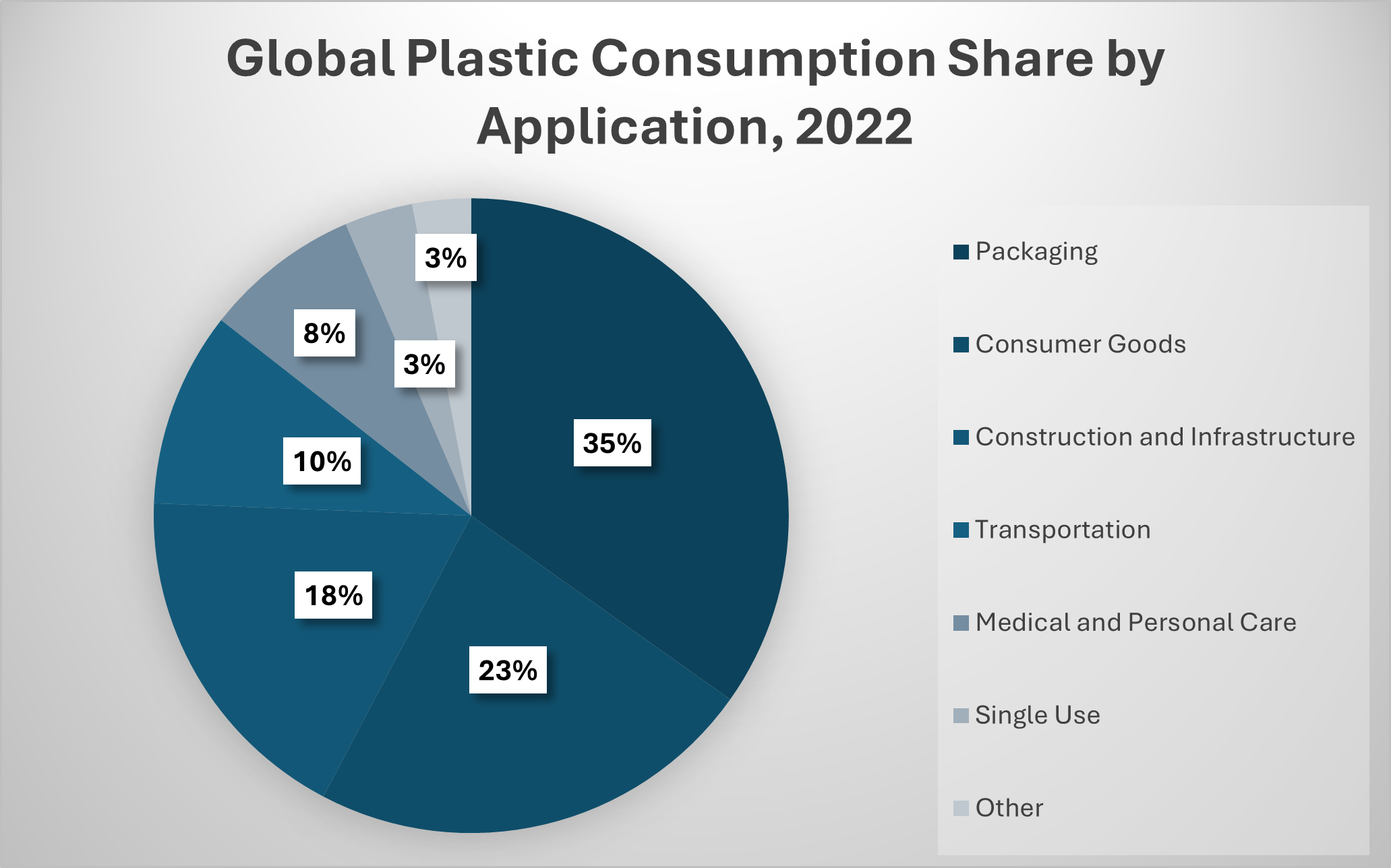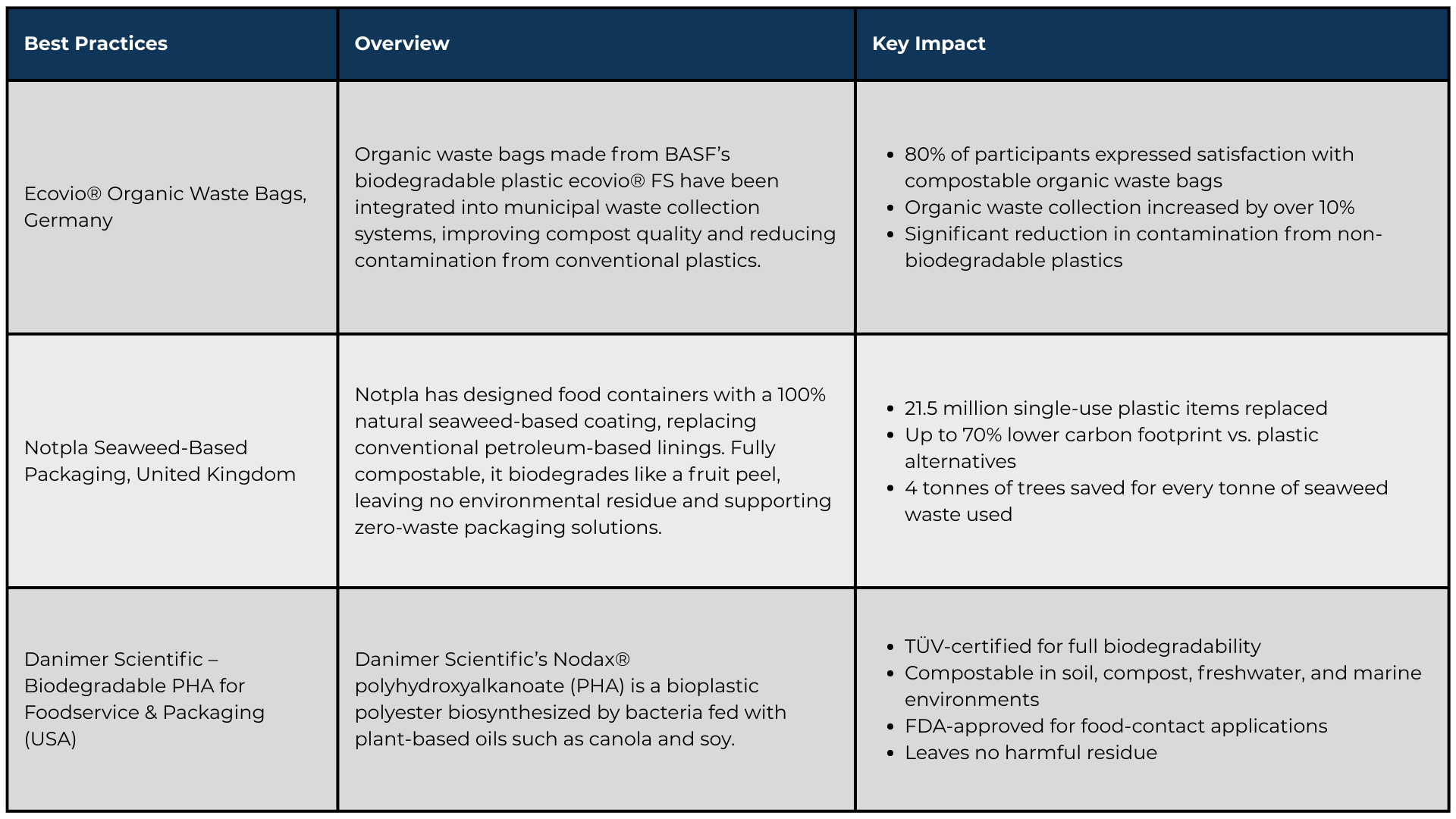
12 May Biopolymers in Packaging: A Game-Changer for Plastic Waste Reduction
By 2050, plastic in the ocean could outweigh fish if current consumption trends continue. Packaging accounted for 36.5% of global plastic use in 2023, with more than 141 million tonnes of plastic packaging waste generated annually.

(Source: Statista)
Plastic packaging persists in landfills and oceans for centuries, emitting microplastics and greenhouse gases over time. This affects marine biodiversity, contaminates soil and food chains, and contributes to climate change—each with costly downstream effects. In low-income regions, improper disposal leads to open dumping and burning, exacerbating public health crises and burdening under-resourced municipalities.
The urgency of the situation is amplified by regulatory pressures, such as the EU’s 2019 directive on reducing single-use plastics, and growing consumer demand for sustainable alternatives. Biopolymers—renewable, biodegradable materials—offer a promising solution to transform the packaging industry and address this crisis.
Biopolymers: A Strategic Solution
Biopolymers are a diverse class of materials derived from renewable biological sources such as starch, cellulose, proteins, and polylactic acid (PLA). They include both naturally occurring and bio-based synthetic polymers, many of which offer biodegradable or compostable alternatives to conventional plastics under specific conditions. These materials can be engineered to match the performance of conventional plastics, making them ideal for packaging applications such as food trays, flexible films, shopping bags, beverage cups, and cosmetic containers. By integrating biopolymers, industries can move towards a circular economy where materials are sustainably sourced, used, and disposed of, significantly reducing environmental impact.
How Biopolymers Help
Biopolymers offer a range of advantages that make them a compelling alternative to traditional plastics:
- Biodegradability: Biopolymers decompose naturally, reducing plastic waste in landfills and oceans. For example, PLA can biodegrade in industrial composting facilities.
- Renewability: Sourced from renewable materials like corn starch or sugarcane, biopolymers decrease dependence on finite fossil fuels.
- Reduced Carbon Footprint: Producing biopolymers generally emits fewer greenhouse gases than traditional plastics, supporting zero-carbon goals.
- Versatility: Biopolymers can be tailored for specific applications, offering properties like transparency, strength, and flexibility, comparable to plastics like PET.
- Consumer Appeal: As eco-consciousness grows, biopolymer packaging enhances brand value by meeting consumer demand for sustainability.
- Functional Enhancements: Innovations like nanofillers improve biopolymers’ mechanical and barrier properties, making them suitable for active and intelligent packaging.
Building on these benefits, several organizations and innovators have successfully implemented biopolymer-based solutions at scale. The following best practices illustrate how biopolymers are being leveraged to reduce plastic waste and drive measurable environmental impact.

Despite their environmental advantages, biopolymers face challenges related to cost and performance.
- For instance, polylactic acid (PLA) can be 20–50% more expensive than conventional plastics due to complex production processes.
- Additionally, some biopolymers exhibit lower heat resistance and moisture barrier properties, limiting their suitability for certain packaging applications.
- While bioplastics are biodegradable, most require high-temperature industrial composting—an infrastructure lacking in many cities. When sent to landfills, they can decompose anaerobically, releasing methane, a greenhouse gas 23 times more potent than CO₂.
- Without appropriate waste management, these materials can fragment and contribute to microplastic pollution, undermining their sustainability benefits.
However, ongoing research and advancements in material science are steadily improving both cost-efficiency and performance, making biopolymers an increasingly viable alternative.
At the Frost & Sullivan Institute, we view biopolymers as a promising area of research in the pursuit of Innovating to Zero plastic pollution and greenhouse gas emissions. To drive the adoption of biopolymers, industry leaders, policymakers, and researchers must work together to build the necessary infrastructure and explore scalable solutions. Adopting biopolymer-based packaging offers a promising alternative to traditional plastics, marking an important step toward a more sustainable and environmentally responsible approach to packaging. Now is the time for stakeholders across industries to invest in research, innovation, and collaboration to unlock the full potential of biopolymers.
Blog by Sakthi Kumararaja,
Associate, Frost & Sullivan Institute
